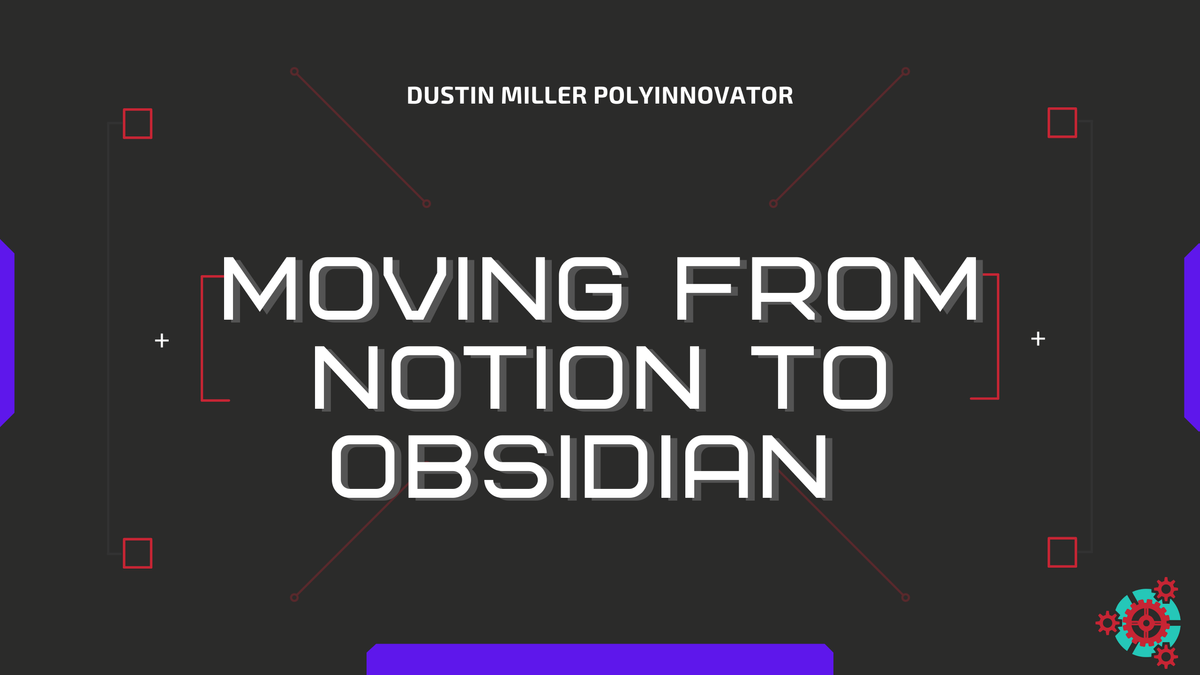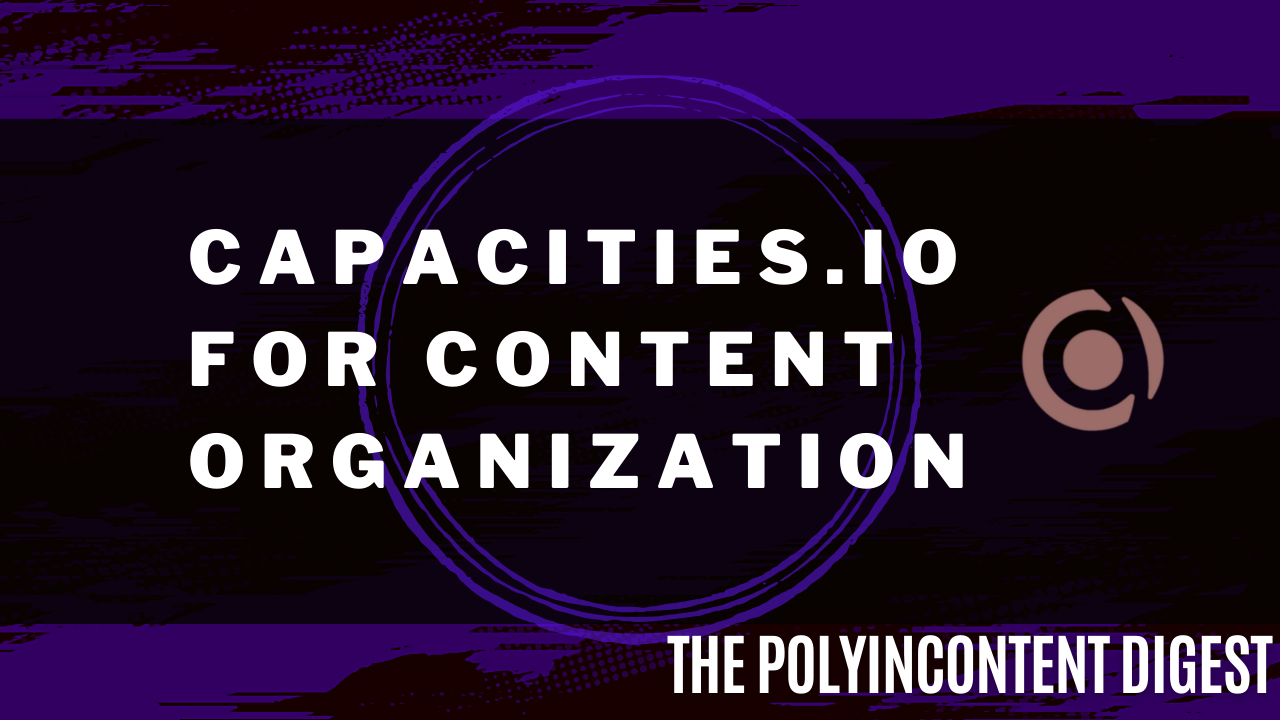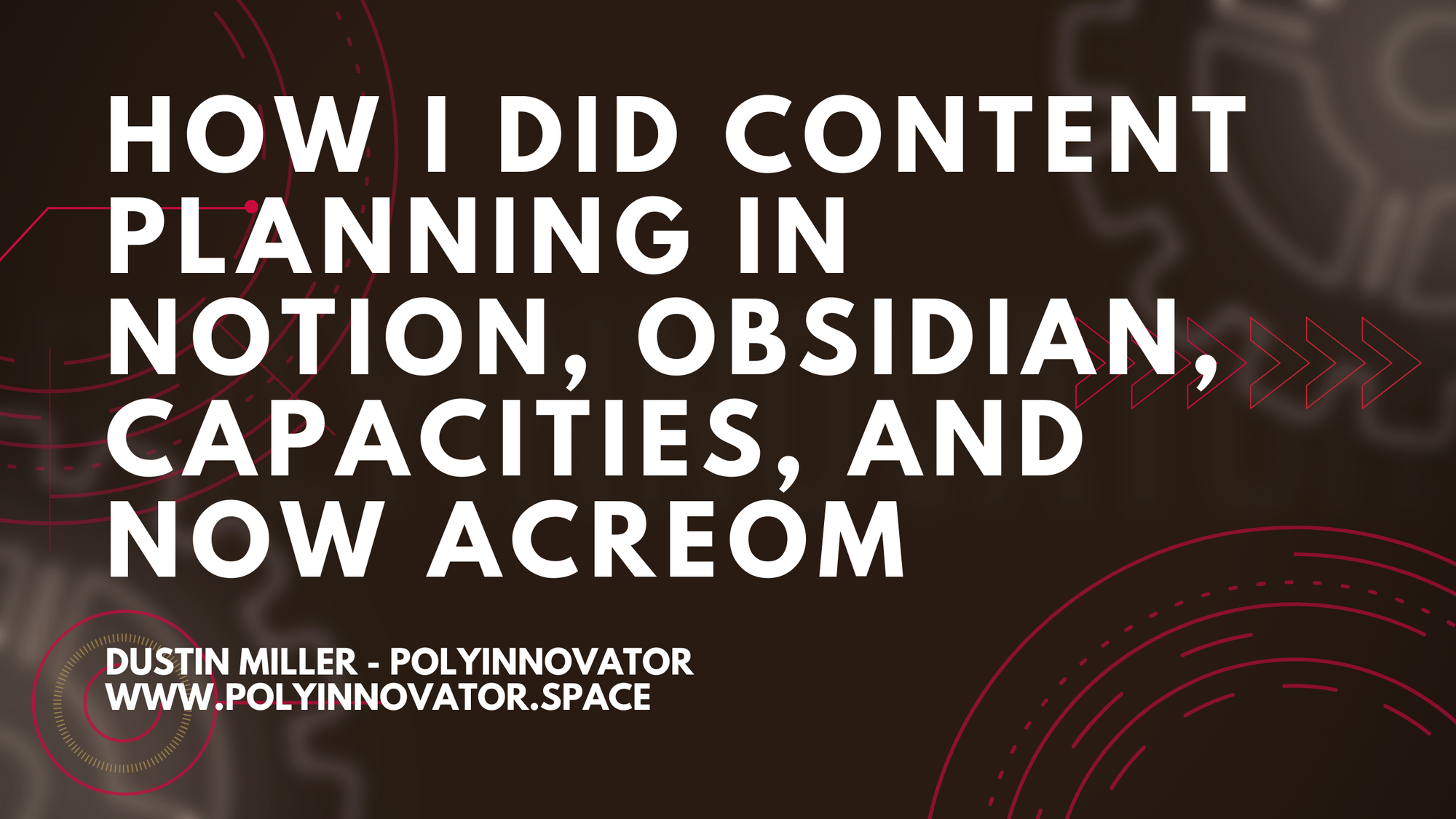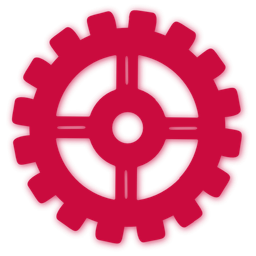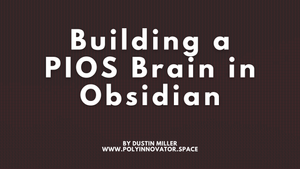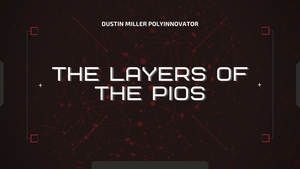After going through a bunch of tools to organize my life, and in particular my content creation planning. I thought it might be helpful to others to share a comparison of sorts of the tools I used.
Each tool brought something to the table, but in the end left something to be desired. Hence why I moved to a new tool, thinking that it would solve that problem. I'm now in Acreom, after trying a ton of more tools, and I think it is going to be a good choice for me now.
Why using a tool to plan out your Content Ecosystem is smart:
A lot of creators just use a google doc to list all of their ideas, and call it a day. Don't do that.
When you have an actual productivity system to plan out your content, then you can create an actual plan of action to achieve.
Even more, you can also have a backup copy of your content, if written, in your tool of choice. So that in case your blog goes down for whatever reason, then you can at least have a back up. There are also other features that might make future content easier to make as well.
Organizing through Databases or Folders
I find myself leaning towards databases given that they give you the control of how you view the data.
Notion and Capacities are the two tools that can do that, as Obsidian's database plugins either don't work or not strong enough. Acreom doesn't have a database, but it has "Views", which at least give a similar feel.
I found it frustrating when I was on notion, that my productivity system information architecture was split between two places. The cloud based Notion and my local folder structure on my PC.
As I had all of the thumbnails, videos, podcasts, etc on my computer.
How I did it in Notion
After trying out DOZENS of project and task management tools to find a way to plan out my content. I found myself at Notion's door... twice.
One common theme with all of these tools is that I did find myself using them, until after I tried them for a SECOND time.

Here is a basic view of how it looked in the database. Lot going on there. Mainly its the title, number, description, status, and then the 3 links: video or podcast or blog or all three.
At the top you can see tabs for each of the content types and/or series.
Highlighted Feature: I mainly used the calendar view for managing my content. I would add them via the database view (never touched kanban), and then mainly interact with posts once they had a date.
Now that notion calendar is a thing, I almost went back to Notion, but I found that I could get a similar experience with Acreom.
How I did it in Obsidian
Ironically this was my weakest tool when it came to this need for content planning. I found myself finally doing daily notes a lot more. The graph view made making connections between notes very interesting. Not to mention a lot better idea emergence.
The bidirectional linking and tagging made coming up with new ideas pretty interesting. Not to mention I could interact with my saved content like articles more, which could then lead to more blog posts being made from me.
However no matter what plugin I tried (I looked through all 1000 of them multiple times), I could not get any plugin to work for this use case. From make.md to "Projects", and even the calendar plugins. They either DID NOT WORK, as in they didn't function most of the time, or they didn't help with making it easier to plan content out.
The only way I was able to get my content planning done in Obsidian was to use a plugin for Reminders. What it did was add a task type, that allowed me to add a date to a task to do that task on that day or time. Then it would put all of the added task dates to a list on the right side bar.
However the sheer tedious-ness of adding dates to task by writing them out in full with no mistakes was so annoying.
It also didn't help if I missed a day. In notion if I got behind I could just drag the item to the next day. I'd have to do that for all of the posts, but at least it was a simple fix times the number of days to catch up. With the reminder plugin I was pretty screwed. Especially it was a weekly thing.
Highlighted Feature: Graph view, it allowed for unparalleled visualization of all of the various posts, tags, and folders for all of my data.
How I did it in Capacities
This was an interesting move as it was more of a combination of how notion and obsidian worked.
I was finally able to use a database again, it was really great to be able to interact in that format. Unlike the tabs in the notion database at the top, there were collections on the left side that were just rows.
This subtle change made it actually work better than notion. Mainly because it took less visual space/clutter, and it was a bit faster.
I did have a lot of performance issues though in Capacities, even after updates. Also there were two critical issues that were never addressed, even when I left the feedback:
- In the database if I were to do something like filter or sort, or make big change like add/remove a property. It would often fail to change the frontend. I'd have to click on another collection (essentially another database) to get it to refresh. WARNING, if you actually pressed the browser refresh, you could lose data.
- One of the biggest annoyances in any tool I've used: Inside the page of an item in the database you can see the properties and the main doc page. In order to interact with a textbox property or the main doc text box. You would have to click 2-3 times in order to activate said box. I've told this to the team many times, and it is the most stupid issue that could be fixed pretty quick. It made moving into capacities 3x harder.

Now I know I trashed on Capacities a little hard there, but I really like the tool. If there were some more features like a calendar view, or solid local app. I would probably be more inclined to pay and become a "believer", but the feature set is just not there.
Highlighted Feature: Object based note taking. They were the pioneers in this new type of note taking tool, and they went full send into it. The way I created my content ecosystem was to make a "content" OBJECT, and then create a new collection for each content type or series. Sort of like database views in notion.
That ended up being a great way to manage everything content related (not as great for the PIOS in some ways).
How I am doing it in Acreom
Now we get to what I am doing now. I had tried Acreom out before, but the performance wasn't there for me. I think it was because I either wasn't patient enough, or the update they sent out made it better.
Now I don't seem to have any issues with it across devices. I'm using the cloud version, but it is synced to a folder on my computer. So I have sort of the best of both worlds, and if my internet goes out I can still work (my ISP has been really bad). This is really important to me to have a tool that works offline, I was just gonna use the local version, but I figured the cloud would be best. Plus you need the cloud version to sync with Google.

You can see on the left my folder structure, this is almost exactly how it was in Obsidian as well. It follows my PIOS framework, and the content are within the Nano layer for input and output.
I just have a little "done" folder in each one as there isn't a way to check off oh this post is done, so I just move it to that folder when I complete the post.
What makes Acreom different however is how it tracks todos and dates.

Every post can be set to a certain date, if you don't set it as todo though it won't show up in the tasks list. Only the calendar which you see above (it isn't a monthly thing, but more of a list of days).
One feedback I sent to the team is that I wish I could drag the page to the next date, so if I ever did miss a day I could easily move them around. However it is pretty quick and easy to just go into the page still and change the date.
Compared to the other tools, it has not been THIS simple to plan out content, SINCE notion.

Since the tool is local I'm more likely to actually do my daily note, plus the writing experience is better than in Capacities. That is a crucial point, as with Acreom and Capacities both. The way to SEE what page or task is due THAT DAY is to have actually gone to that daily note.
If the habit isn't formed to be writing every day, or to at least check the note, then this feature doesn't help you.

Here are what the tasks look like, you can do check box tags as well. With a toggle those can appear on here as well.
Highlighted Feature: Quick capture. At any point, as long as the app is open, you can press control shift space, and this window will pop up. I wish I could choose a specific folder or page more easily so I can make a spot specifically for these quick ideas, but the point remains. It is a really convenient feature.

Check out Acreom!

Why did I move through these tools?
First and foremost I want to address that I do not think it was "shiny object syndrome", that many people face when it comes to PKM tools.
Oh you see some new feature in a tool, and you really want to use it. Granted I do get that, but I don't move my entire PIOS over to a new tool just for that.
This came out of necessity. I was so frustrated by the overrated Notion, and the fact that it only helped me with content. I never took daily notes, did task management, and barely did my Modular Degree within Notion.
Using Obsidian was the idea because all of my data would be local, and then I could use something like AutoGPT to train on my data, and become a proto jarvis for myself. Ironically I never got around to doing that much, so it was sort of a waste. Though I learned a lot.
Frustrated by the lack of being able to plan out my content, I then moved to capacities, as I didn't want to go back to notion.
In capacities I thought that was gonna be my new home, but he PIOS didn't translate great, the performance was lacking, communication from the team was lacking, and even copying to and from capacities was rather bad. I store my blog post templates in my PKM, and so I copy them from there to my CMS. They would lose all formatting when copied over.
Acreom seems to have fixed all those issues, and even gave me a nice task management system too. While I've had hiccups, and even almost lost my data once (which was because of my ISP not Acreom), the tool seems to be getting regular updates. Not to mention the team has actually communicated a lot with me. That is the flow of all of these tools for me, and I hope this helps you.
Read more from this Knowledge Management Tag:


--
